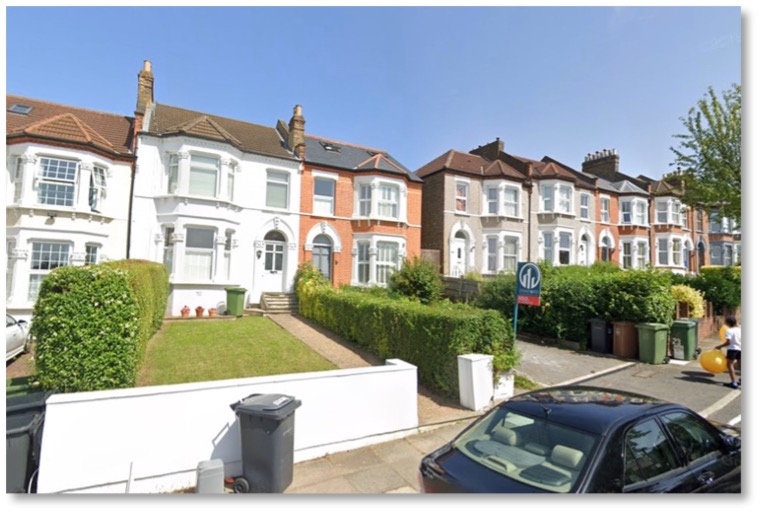“The Missing School”
Unlike many other roads on the estate where the name derives from a village or town in Scotland, Abbotshall Road seems likely to have been named after a whole Parish – that of Abbotshall, Kirkcaldy, in Fife. There is an Abbotshall Parish Church in Abbotshall Road in Kircaldy. Apparently the Abbots from nearby Dunfermline made their home there, which is where the name comes from.

The old Abbotshall Parish Church in Kircaldy, Scotland
The Parish is about 55 miles east of Glasgow, Archibald Corbett’s home city. Quite how or why he chose the name Abbotshall is unknown, but as a deeply religious person, the connection to men of the cloth would surely have appealed to him.
Abbotshall is a mid-sized road in the Corbett estate, with houses situated only on the east side, because on the west side is the Abbotshall Playing Fields. The road is between Dowanhill to the North and Ardoch to the south. Merchiston Road runs into it from the west.
Building of the street commenced in 1907, and when it was finished there were 31 houses. The 1911 census recorded 129 people residing in the road. That equates to 4.16 people per house – a mid-range average on the Estate. Possibly because of the hilly ground on which it’s built, which limited the grid-style layout of streets in this section of the Estate, some of the houses have very long front and rear gardens – amongst the longest of any Corbett houses.

Modern day Abbotshall Road showing the long front gardens
The Early Residents: details from the 1911 Census
Abbotshall was also unusual because there were more males than females living there. This is one of only four roads where this occurs in the 27 on the estate, with 52.7% of the residents being men and boys and 47.3% being women and girls. The Estate average was 53% female and 47% male.
There were no clear winners for the most popular adult female first name here, but there were three Jessies and two of each named Emily, Florence, Louisa, Mary, Nellie and Sarah. The male equivalents being Arthur and Albert. This is somewhat different to other roads since Mary and William were by far the most popular male and female adult names in the estate. For children, it was Dorothy and Olive (two of each name) and Frederick in Abbotshall.
As with almost every other street, the most popular kind of work for the citizens of Ardgowan Road was as a Clerk. Of the 58 people in employment, 13 said that they did some sort of office job (Clerk). Amongst the non-office workers, there was a ‘Maltster’ at No. 61 (see more below).
There were joint winners of the street record for the highest number of children in a single family: the Saverlands at No. 5 and the Lenihans at No. 63: each had five children. This means there were at least 7 people living in those houses.
At number 21 lived Minnie Maria Barber Gregory who takes the road’s prize for ‘resident from furthest away’: she was from Anaghmore, Armagh. Overall, the vast majority of the street’s residents (70%) had been born in London (a little lower than the Estate average of 72%).
The oldest resident at the time of the 1911 census was Mary Anne Stevens who lived at No.5. She was 78 years old.
An early school
There were four schools built on the Corbett Estate and one of these used to be on the site of what is now the Abbotshall Playing Fields. It was known as the ‘’Abbotshall Road Temporary School’’ and existed between 1913 and 1922. It was probably built of corrugated iron like another temporary school in the estate at Hazelbank Road, where the allotments are today.
The school possibly became a small clothing factory during the Second World War, because bomb damage maps for the area show that a clothing factory on the Playing Fields site was destroyed in a raid which also badly damaged houses in nearby Dowanhill Road.
HISTORICAL CONTEXT
At No. 61 Abbotshall in 1911 we find Arthur William Joseph Corr, who was a lodger with the Simons family and who defined his employment as that of a Maltster. The maltster was employed (usually by a brewery) to select cereals, mainly barley, from the growing fields, for malting. The barley could also be grown on a brewer’s premises.
The maltster would then modify the barley, using nature as part of the process, to allow the brewmaster to be able to make beer from it. The barley was malted to the brewmasters specification, to ensure the brewmaster being able to produce the beer flavour, and alcohol content desired.
At the time of the 1911 census there were many breweries in London such as Truman and Watney where a maltster may well have been employed. It would also have been possible that Arthur Corr may have had easy access to farms growing barley.